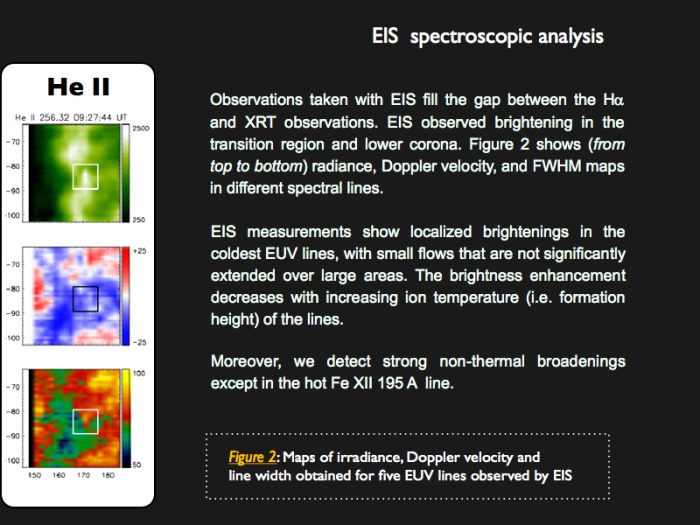Motivation
The interaction between emerging magnetic flux and pre-existing ambient field has become
a "hot" topic for both numerical simulations and high-resolution observations of the
solar atmosphere at different spatial scales (e.g. see
previous nugget). The appearance
of brightenings and surges during episodes of flux emergence is believed to be a signature
of magnetic reconnection processes. In this nugget we look at the configuration and evolution
of a small-scale emergence flux region (EFR) in NOAA 10971 observed simultaneously with
the Hinode satellite and ground-based facilities.
Joint Observations
Data were acquired during the HOP 14, a joint campaign between
the solar telescopes of the Canary Islands and Hinode. On September 30, 2007, the
active region NOAA 10971 was observed with the Solar 1-m Swedish Telescope (SST)
and the instruments onboard Hinode. See the video below describing the observations
and the region of interest through the diverse observed spectral lines.
The measurements cover a period of ~2 hours and wavelength range from
visible to soft X-rays.
This is movie:
* To see the movie, you may need quicktime plugin for your browser installed beforehand.
Alternatively, download the movie: Nugget.m4v and play with Quicktime player.
Analysis
 Figure 1: Multi-wavelength observations of the EFR observed on 2007 September 30. The box indicates the location of the studied event. Click image to see full size version
Figure 1: Multi-wavelength observations of the EFR observed on 2007 September 30. The box indicates the location of the studied event. Click image to see full size version
A critical step in multi-instrument observations is the co-alignment of the different datasets.
Figure 1 summarizes the evolution of the EFR displaying a small-scale brightening (white box in
Ca II H and Hα lines) associated with the reconnection of emerging magnetic field lines into a
pre-existing ambient field.
The granulation pattern inside the white box appears disturbed and more elongated than is
typical in the quiet sun. Upward velocities of 1.5 km/s associated with strong horizontal
fields of 1.5 kG are found, supporting results from numerical simulations (
Cheung et al, 2007, 2008).
The site of the CaII H brightening coincides with the footpoint of an X-ray loop with
enhanced emission, which could be a jet. In fact, various phenomena indicating the release
of energy and resulting plasma heating occurred at the EFR site, i.e. brightenings in
CaII H, Ha and EUV lines, intensity enhancements in X-rays, and Ha surges.

Topology of the region
The analysis points to the emergence event as the likely trigger of the reconnection process,
due to the interaction between the pre-existing arcades and the EFR field lines.
LFFF extrapolations are performed to determine the coronal connectivity above the EFR
(see
Figure 3). The results suggest that as the positive polarity of the EFR appears on
the surface with its conjugate negative polarity, the footpoint separation increases due
to the diverging motions, so the emerging lines bulge upwards. They push the overlying
arcades and force reconnection thereby producing sets of long loops (surges) and small loops (brightenings).
Figure 3: on the right, Large-scale view of the potential extrapolations in the EFR site. Red lines represent field lines connecting main polarities. Thick coloured lines show selected field lines describing the topology of the EFR.
Conclusion
The combination of multi-wavelength observations and detailed magnetic field
extrapolations enable us to understand complex events in the solar atmosphere such as
the EFR events presented in this nugget.
These solar processes are difficult to interpret and by gathering information from an
ample wavelength coverage we can follow the evolution and intrinsic properties of events.
Observational evidence should be complemented with advanced realistic simulations to understand
physical phenomena at different scales in the Sun.
This nugget is the summary of a paper in :
Astrophysical Journal (in press), by S. Guglielmino, L. R. Bellot Rubio, F. Zuccarello, G. Aulanier, S. Vargas
Domínguez and S. Kamio
— click this link to download online version


